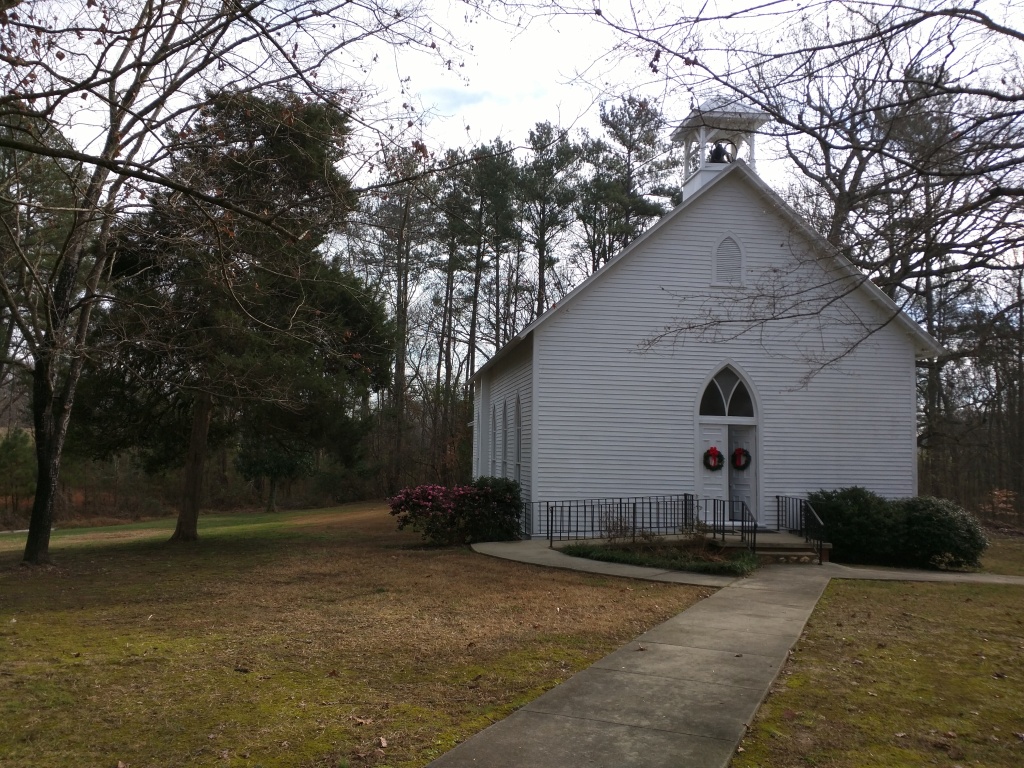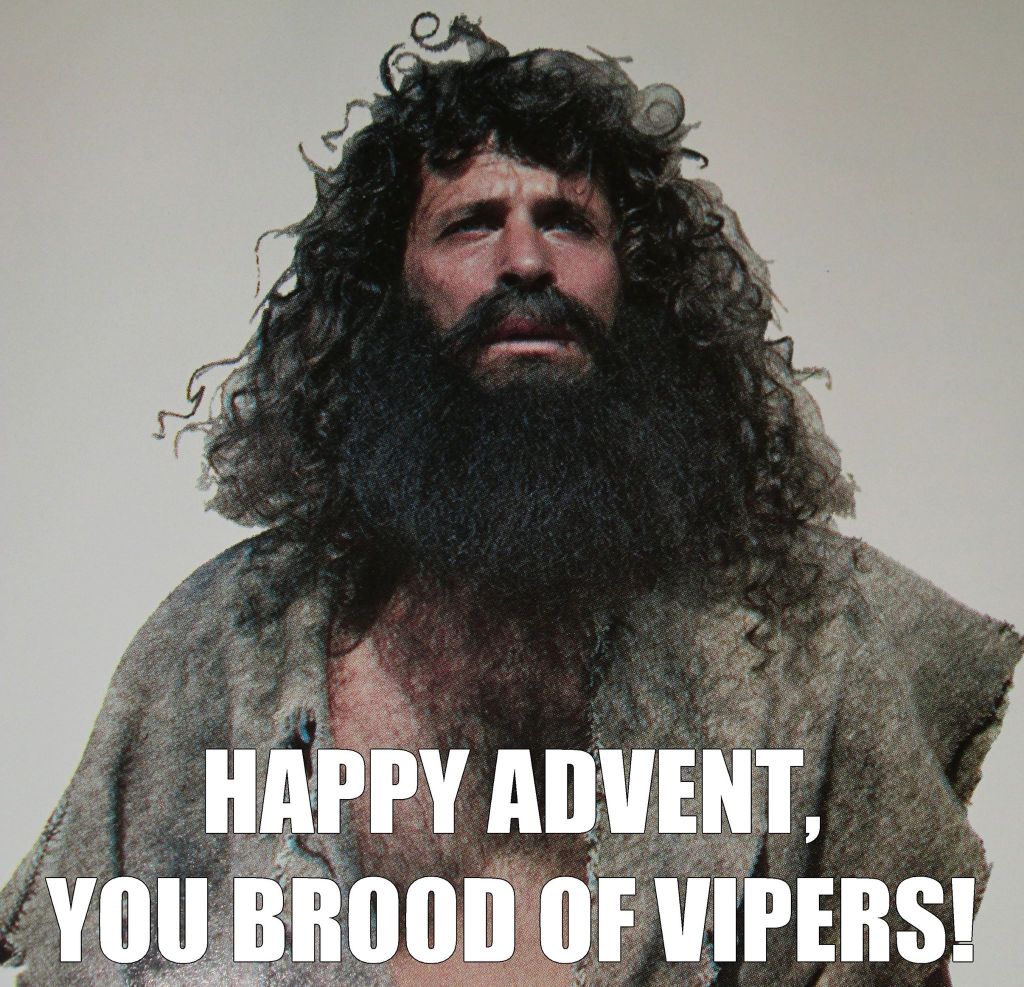Advent, John the Baptist and Preparing for a Break

“John said to the crowds that came out to be baptized by him, “You brood of vipers! Who warned you to flee from the wrath to come? Bear fruits worthy of repentance. Do not begin to say to yourselves, ‘We have Abraham as our ancestor’; for I tell you, God is able from these stones to raise up children to Abraham. Even now the ax is lying at the root of the trees; every tree therefore that does not bear good fruit is cut down and thrown into the fire.” (Luke 3:7–9 NRSV)
This is the message I gave at Spring Friends Meeting Dec. 13, 2015
The Force of Togetherness
Usually, when we think and talk about Christmas, we think of it as a time to be together with loved ones. Christmas is the time when school shut down and students return home. It’s a time when the airports are full of hustle and bustle as sons and daughters try to make their way back home with the grandchildren in tow. It’s a time of the equally loved and hated office Christmas parties. There’s carol singing with friends. And at least for me, I can count on gaining at least a few pounds, because of all the baked goods that enter circulation. It’s also a time of great family tradition and religious traditions. I really do love this time of year, I love the opportunity to reflect on the biblical texts that surround this particular narrative. I love considering the Spirit of Christmas.
I love Christmas eve services and yes, I love all the Trader Joe’s Christmas cookies.
If we are fortunate, if things have gone more or less okay in our lives than most of us don’t have to do any of these things alone.
Christmas really is a time of togetherness.
But togetherness is not all it’s cracked up to be.
Togetherness, even at Christmas time, isn’t something we all look forward to. For some of us, returning home brings up immediate anxiety. For others, the thought of another Christmas going by where we the finances will be stretched to the max is disheartening. For others, there is no family to connect with so being on the other side of togetherness has its own pain.
Togetherness in its most unhealthy form is what psychologists call “enmeshment.” It can keep us from being unique, from thinking and acting for ourselves, from going against the grain or even just doing something different.
An example of the problem of togetherness is Starbucks new holiday cup. Starbucks decided this year to not have any “Christmas” imagery on their to go cups. As opposed to other years, they skipped the deeply religious symbols of a snowflake and frosty the snowman (as Colbert would say). And because of it, many who identify as Christians were in an uproar over the attack on Christmas.
Richard Rohr describes the problem of togetherness within family systems, as the crab in the bucket syndrome where every time one crab tries to get out of the bucket all the other crabs pull it back down.
Q: How many of you know what I’m talking about?
So what does this negative force of together have to do with this season advent and John the Baptist?
John Prepares for the Cut
As I read John the Baptist in light of the troubles of today, I see that in order for us to be able to enter fully into expectant waiting, ready to respond to the coming call of Christ, we need to be cut free from this form and force of togetherness.
This is because John’s message during advent is itself a break.
It is a break with older regimes.
It is a break that comes with a cost to our prior experiences, community, family and traditions.
It is a break with our own self-congratulatory grandiosity.
It is a break from our previously held ideas and actions.
If advent is about preparation, then John’s placement within the Christmas story is meant to shed us from this idea of togetherness. He is presented as the prophet with an ax, ready to cut his hearers free from the entanglements of togetherness which he knows will be carcinogenic to the work of the Gospel.
And isn’t it this break with togetherness that makes John’s message so challenging to hear anytime, let alone at Christmas?

John the Baptist was never much for sending out holiday greeting cards, but a few of his less successful one-liners were:
You brood of vipers! Who warned you to flee from the wrath to come? Merry Christmas and Happy New Year!
Do not begin to say to yourselves, ‘We have Abraham as our ancestors…even these stones will raise up children to Abraham.’ – Happy Hanukah
Even now the ax is lying at the root of the trees.” – Joy to the world.
Not really summoning “It’s a Wonderful Life” for you is it?
But this is no greeting card Christmas message, it is a challenging invitation to re-envision the world.
For John: The birth of Christ in their world and ours is one that cannot be received by a shortcut – John asks, “who warned you?”
The birth of Christ take places outside and on the margins of society, in the barrios and in the ghettos cannot be recognized by the self-congratulatory grandiosity of resting on the witness and good deeds of our forefathers and foremothers – John says, “Do not begin to say to yourselves.”
The birth of Christ was witnessed by those who were themselves cut off, isolated from those who claimed that “we are all in this together” – John says, “even the stones will cry out.”
The birth of Christ comes as a contrast to those with power, fanfare, deep pockets and a political voice – John says, “Even now the ax is lying at the root of the trees.”
John prepares the way by preparing us for a break from a togetherness that has been used to suppress and oppress. A break from a togetherness that has become itself the ends rather than the means. A break from a togetherness that will ensure that nothing ever changes and that the world is not set to rights. A break from a world where to voices of the small are drowned out by the footsteps of the mighty. And so embedded within John’s fiery message is great hope.
Moving Forward Together
With an ax lying at the root of trees, John reminds us that we must challenge every form of sin that comes in the form of togetherness so that we might move forward into Jesus’ new movement of love.
White Supremacy is a form of togetherness that outlines and violently enforces otherness.
Our economics system based on a 1% / 99% structure is togetherness in the name of trickle down economics.
These hateful and misrepresenting remarks about Muslims is a what togetherness looks like when group identity must be maintained by a declaring a wicked other.
Many of the issues within our Quaker YMs are a togetherness at the expense of being faithful to Jesus who is the living and present teacher in our midst.
These are all forms of togetherness that John, and Jesus call us to break free from. The Gospel cannot be understood and lived within the confines of these insidious interpretations of “For the family” or “for the good of the community.”
John’s message is like an inconspicuous person who has found the escape hatch and is quietly and carefully whispering to others who are caught following suit with their captors. This is urgent. It is crass. It is no chestnuts roasting over an open fire, but it is indeed cut through with the heat of real fire.
If we are to step off the conveyor belt that is headed off the cliff, we need to heed this prophet crying out in the wilderness.
Advent is a break with togetherness so that we might move forward together in a new way; one rooted in sacrificial love and compassionate towards neighbors and enemies alike.
John is not some anti-communitarian or rugged individualist.
Instead John is like the doctor preparing to clip the umbilical cord. A cord that is at once a universal life force and can if not cut at birth quickly become a leash in our development.
When the crowds press, “okay, if you are right, what should we do? What happens after the cut is made?”
John pushes them to form community in a new way (Lk. 3:10-14).
Live a simple life so that there is enough to go around.
Share your clothing with others.
Share you food.
Don’t hoard or stock up more than what you need.
Do not use your power to get whatever you want or to tear people’s lives a part.
In other words, be cut free the way the world works so that you might live freely for one another.
Be cut free so that you might love one another outside the confines of togetherness.
Be cut free so that you can truly embrace what is to come on Christmas morning.
Be cut free so that out of freedom you may build a communion of love that will embody this love in the world.